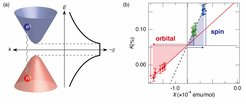Giant orbital diamagnetism of three-dimensional Dirac electrons in Sr3PbO antiperovskite
Orbiting of Dirac electrons gives rise to a giant diamagnetism
Dirac electrons formed in topological semimetals show many unconventional properties including chiral anomalies and quantum Hall effect with unusual phase shift at a high temperature. Giant orbital diamagnetism is one of the unusual properties of Dirac electrons but distinct from the well-studied others. It is not an electronic transport but a magnetic property. It originates from an inter-band effect rather than intra-band effect. Not only electrons at the Fermi level but all Dirac electrons contribute to the diamagnetic response.

Diamagnetism was first discovered in 1778 by Anton Brugmans in elemental Bi. In retrospect, his observation was likely enabled by the large diamagnetism of Bi compared with conventional diamagnetic insulators. Many years later, the origin of the giant diamagnetism in Bi emerged a big puzzle in condensed matter physics. After decades of debate, the effect was theoretically understood to arise from the orbital magnetism of Dirac electrons via inter-band mixing, and recent reports of large diamagnetism in the bulk magnetic susceptibility of several Dirac semimetals have been similarly interpreted. To our surprise, however, no direct experimental evidence for the giant orbital diamagnetism of Dirac electrons has been provided so far even in Bi, as it is nontrivial to experimentally identify the “orbital contribution” of “Dirac electrons” in the magnetic response.
Our work on the three-dimensional Dirac electron system Sr3PbO provides for the first time an experimental proof that the giant diamagnetism indeed originates from the orbital magnetism of Dirac electrons, based on a very careful analysis of the NMR Knight shift and the spin relaxation rate together with the bulk magnetic susceptibility.
Jürgen Nuss











